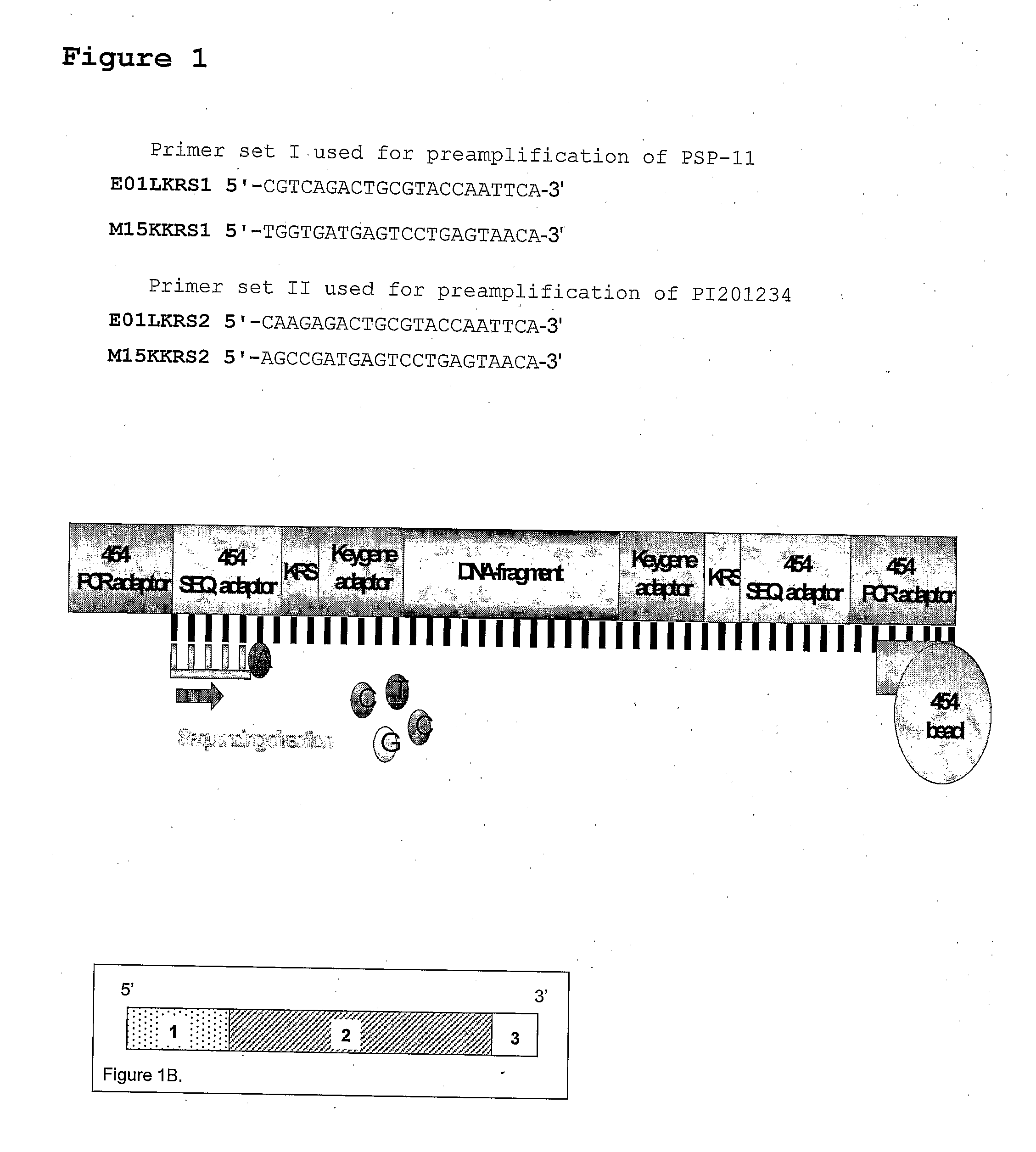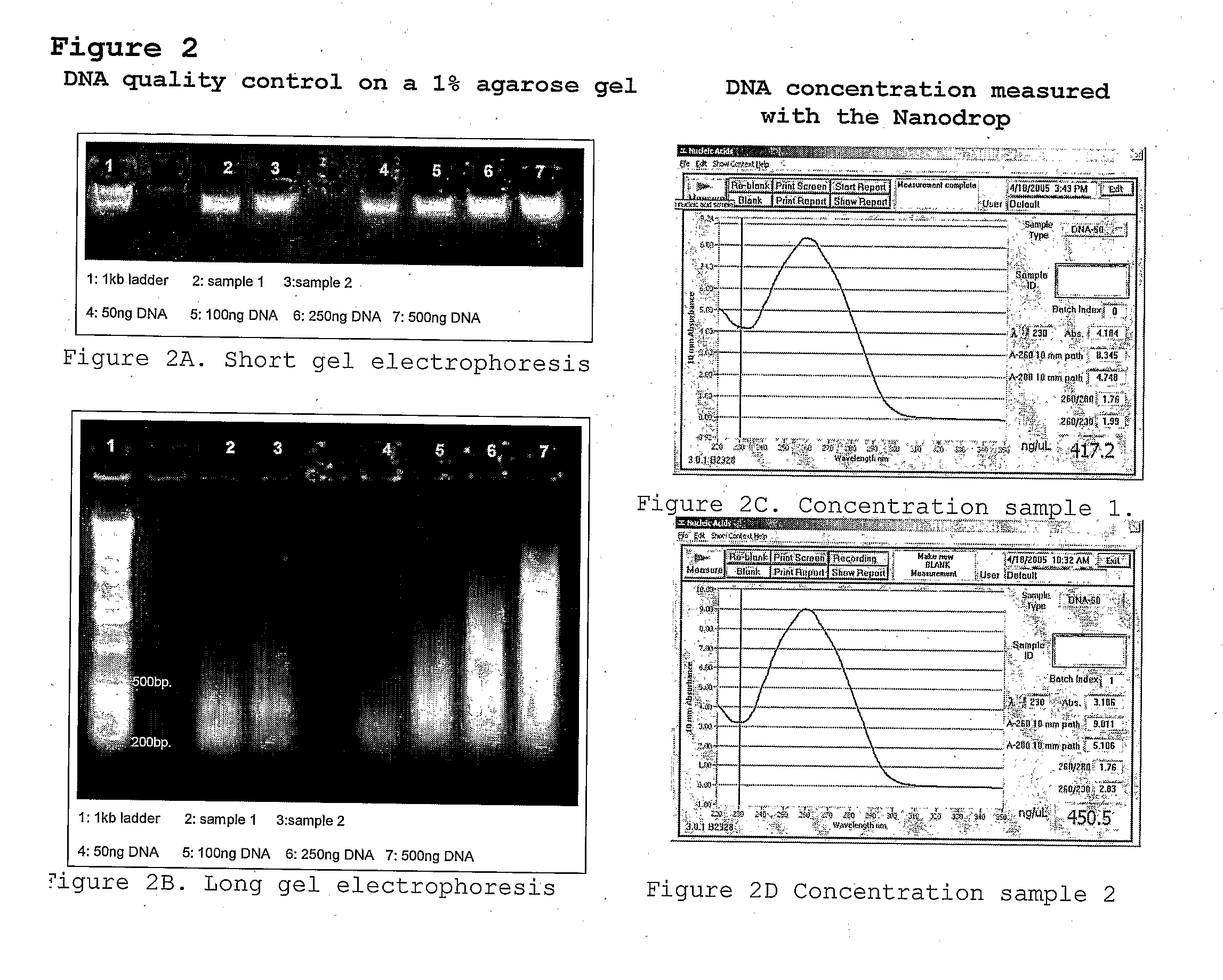Method for high-throughput aflp-based polymorphism detection
a polymorphism detection and high-throughput technology, applied in the field of molecular biology and genetics, can solve the problems of high throughput of aflp, high rate limiting step of electrophoresis, and inability to identify polymorphisms in large samples such as genomes, and achieve the effect of screening large amounts of samples simultaneously
- Summary
- Abstract
- Description
- Claims
- Application Information
AI Technical Summary
Benefits of technology
Problems solved by technology
Method used
Image
Examples
example 1
Pepper
[0117]DNA from the Pepper lines PSP-11 and PI201234 was used to generate AFLP product by use of AFLP Keygene Recognition Site specific primers. (These AFLP primers are essentially the same as conventional AFLP primers, e.g. described in EP 0 534 858, and will generally contain a recognition site region, a constant region and one or more selective nucleotides in a selective region.
[0118]From the pepper lines PSP-11 or PI201234 150 ng of DNA was digested with the restriction endonucleases EcoRI (5 U / reaction) and MseI (2 U / reaction) for 1 hour at 37° C. following by inactivation for 10 minutes at 80° C. The obtained restriction fragments were ligated with double-stranded synthetic oligonucleotide adapter, one end of witch is compatible with one or both of the ends of the EcoRI and / or MseI restriction fragments. The restriction ligation mixture was 10 times diluted and 5 microliter of each sample was pre-amplified (2) with EcoRI +1(A) and MseI +1(C) primers (set I). After amplifi...
example 2
Maize
[0162]DNA from the Maize lines B73 and M017 was used to generate AFLP product by use of AFLP Keygene Recognition Site specific primers. (These AFLP primers are essentially the same as conventional AFLP primers, e.g. described in EP 0 534 858, and will generally contain a recognition site region, a constant region and one or more selective nucleotides at the 3′-end thereof.).
[0163]DNA from the pepper lines B73 or M017 was digested with the restriction endonucleases TaqI (5 U / reaction) for 1 hour at 65° C. and MseI (2 U / reaction) for 1 hour at 37° C. following by inactivation for 10 minutes at 80° C. The obtained restriction fragments were ligated with double-stranded synthetic oligonucleotide adapter, one end of witch is compatible with one or both of the ends of the TaqI and / or MseI restriction fragments.
[0164]AFLP preamplification reactions (20 μl / reaction) with +1 / +1 AFLP primers were performed on 10 times diluted restriction-ligation mixture. PCR profile: 20*(30 s at 94° C.+...
example 3
SNP Validation by PCR Amplification and Sanger Sequencing
[0181]In order to validate the putative A / G SNP identified in example 1, a sequence tagged site (STS) assay for this SNP was designed using flanking PCR primers. PCR primer sequences were as follows:
Primer_1.2f:[SEQ ID 33]5′-AAACCCAAACTCCCCCAATC-3′,andPrimer_1.2r:[SEQ ID 34]5′-AGCGGATAACAATTTCACACAGGACATCAGTAGTCACACTGGTACAAAAATAGAGCAAAACAGTAGTG 3′
[0182]Note that primer 1.2 r contained an M13 sequence primer binding site and length stuffer at its 5 prime end. PCR amplification was carried out using +A / +CA AFLP amplification products of PSP11 and P1210234 prepared as described in example 4 as template. PCR conditions were as follows:
For 1 PCR reaction the following components were mixed:
5 μl 1 / 10 diluted AFLP mixture (app. 10 ng / μl)
5 μl 1 pmol / μl primer 1.2 f (diluted directly from a 500 μM stock) 5 μl 1 pmol / μl primer 1.2 r (diluted directly from a 500 μM stock)
5 μl PCR mix2 μl 10 × PCR buffer1 μl 5 mM dNTPs1.5 μl 25 mM MgCl20....
PUM
| Property | Measurement | Unit |
|---|---|---|
| Temperature | aaaaa | aaaaa |
| Molar density | aaaaa | aaaaa |
| Molar density | aaaaa | aaaaa |
Abstract
Description
Claims
Application Information
 Login to View More
Login to View More - R&D
- Intellectual Property
- Life Sciences
- Materials
- Tech Scout
- Unparalleled Data Quality
- Higher Quality Content
- 60% Fewer Hallucinations
Browse by: Latest US Patents, China's latest patents, Technical Efficacy Thesaurus, Application Domain, Technology Topic, Popular Technical Reports.
© 2025 PatSnap. All rights reserved.Legal|Privacy policy|Modern Slavery Act Transparency Statement|Sitemap|About US| Contact US: help@patsnap.com



